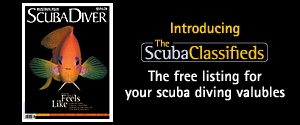
D70 Macro
Contributed by Elsa added 2005-04-18
Replies of 5
- Kath added 2005-04-20
 There is a fab book (advert on this site) An Essential Guide to Digital Photography by Michael AW with Mathieu Meur and it has great basic things for better underwater photography regardless of if you use digital or SLR.
There is a fab book (advert on this site) An Essential Guide to Digital Photography by Michael AW with Mathieu Meur and it has great basic things for better underwater photography regardless of if you use digital or SLR.
I have a Canon with inbuilt flash and some of the info on strobes has extended the limited use of the inbuilt dramatically. Then there's the old practice, practice and more practice. Go back to beginer level and experiment until you find the setting that works, as with all photography the 'right' setting isn't always the 'best' setting to get the result your after.
Cheers
I bubble and bubble no toil nor trouble
-
 Tim Hochgrebe added 2005-11-14
Tim Hochgrebe added 2005-11-14
yoho that's right - get that book right here on the site
Cheers
Tim
Tim Hochgrebe
http://www.underwater.com.au
Dive in, Explore ... and Save!
- ElsaH added 2005-12-08
Thanks - I already got the book, and no it doesnt give the answer, but yes, I did get the answer from Sea & Sea.
Kath - it is rather impractical to go "experiment" if you have one or two dives a weekend. Why waste time that could be spent more productively?
Talking about the book - it is excellent - I will recommend it anyday
- Wildshotz added 2005-12-08
Kath.. Firstly, Shoot in RAW format, Use manual settings in the D70 and strobes, Set camera to single servo, I tend to take an exposure reading about 45 degrees from the sun spike and use that as my camera setting (this gives you a lit background). Use the strobes as fill light for your subject and adjust the power settings on the strobes according to the histogram.If you don't know how to read a histogram, LEARN as this is what tells you how well you exposed the shot. DO NOT RELY ON THE REAR DISPLAY FOR EXPOSURE SETTINGS, only the histogram. The histogram tells you about your exposure and you adjust the strobe settings or camera settings as needed. Also, Use daylight white Balance as you can adjust that in computer later. I will take exposure readings (45degrees from the sun burst) every 15-20 mins or so,, More if it is late afternoon. Night shots are solely lit by your strobes. Again, Set your desired aperture and shutter speed and put your strobes onto full power, take a test shot ( check your histogram)and adjust the strobe setting to suit. Go to a site called dpreview/forums/D70 and do a search on reading Histograms or just read the manual that came with the camera.. Auto settings are crap underwater, so don't even bother to try and use them....The camera and it's auto settings are designed for land!! The Auto features on the strobes are designed for underwater!! Can you see the conflict.. Take control of the equipment yourself and your photo experience will be far more rewarding!
For macro, The same applies except on how you breathe. Don't inhale and hold your breath,, Exhale and hold.. The critter will emerge as it's surroundings have just changed. If you need to inhale, take short controlled breathes in order to control your boyancy and not have to exhale as often and scare the critter away.
I use a similar tequnique with sharks so they come closer to me for the shot.. NEVER chase a critter underwater.. You will always lose, Be patient and just wait.. They are just as curious about us, but are far more timid!
Check my images at http://wildshotz.smugmug.com/
Hope this helps..
David
You can view images at http://wildshotz.smugmug.com
- Wildshotz added 2005-12-08
Sorry, Mean't for Elsa. Firstly, Shoot in RAW format, Use manual settings in the D70 and strobes, Set camera to single servo, I tend to take an exposure reading about 45 degrees from the sun spike and use that as my camera setting (this gives you a lit background). Use the strobes as fill light for your subject and adjust the power settings on the strobes according to the histogram.If you don't know how to read a histogram, LEARN as this is what tells you how well you exposed the shot. DO NOT RELY ON THE REAR DISPLAY FOR EXPOSURE SETTINGS, only the histogram. The histogram tells you about your exposure and you adjust the strobe settings or camera settings as needed. Also, Use daylight white Balance as you can adjust that in computer later. I will take exposure readings (45degrees from the sun burst) every 15-20 mins or so,, More if it is late afternoon. Night shots are solely lit by your strobes. Again, Set your desired aperture and shutter speed and put your strobes onto full power, take a test shot ( check your histogram)and adjust the strobe setting to suit. Go to a site called dpreview/forums/D70 and do a search on reading Histograms or just read the manual that came with the camera.. Auto settings are crap underwater, so don't even bother to try and use them....The camera and it's auto settings are designed for land!! The Auto features on the strobes are designed for underwater!! Can you see the conflict.. Take control of the equipment yourself and your photo experience will be far more rewarding!
For macro, The same applies except on how you breathe. Don't inhale and hold your breath,, Exhale and hold.. The critter will emerge as it's surroundings have just changed. If you need to inhale, take short controlled breathes in order to control your boyancy and not have to exhale as often and scare the critter away.
I use a similar tequnique with sharks so they come closer to me for the shot.. NEVER chase a critter underwater.. You will always lose, Be patient and just wait.. They are just as curious about us, but are far more timid!
Check my images at http://wildshotz.smugmug.com/
Hope this helps..
David
You can view images at http://wildshotz.smugmug.com
You can view images at http://wildshotz.smugmug.com
Replies of 5
![]() Login or become a member to join in with this discussion.
Login or become a member to join in with this discussion.

 Sea-Doo Seascooter Australia
Sea-Doo Seascooter Australia
Exclusive official distributor and dealer for SEA-DOO Seascooters in Australia and New Zealand. The revolutionary SeaDoo Seascooter series feature the lightest and most efficient personal water propellers in the world at a price that won't break the bank.
Articles
-
 The journey continues ...
The journey continues ...
by Ric Mingramm
- Once upon a time ... Ok I won't go back too far. In 1980 courtesy of you, the tax payer, I was fortunate enough to have the Royal Australian Navy pay for my PADI Open Water Course ...






